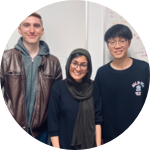
Team Yeast Feast
More
PI: Dr. Anum Glasgow, assistant professor. I started my group in 1/2022. Recently, I designed the first de novo ligand binding site in a protein-protein interface to build chemically inducible sense/response systems; determined the allosteric mechanism of a classic transcription factor; and developed potent, mutation-robust therapeutics to treat SARS-CoV-2 infections. In our research group, we study the evolution of allosteric signal transduction in protein families, develop therapeutics, and build new technologies and software for high-throughput predictions of mutation-driven conformational changes in proteins.
Scientist: Kyle Weber, graduate student. Expertise: protein design, bioinformatics. Kyle joined our group as a technician in 1/2022 and is now as a 2nd-year graduate student. He grew up watching citrus trees in rural Florida die from a disease called citrus greening, which motivates his work in protein engineering for environmental applications. Here, Kyle has spearheaded the development of a new biotherapeutic format. Kyle and Chenlin are now computationally redesigning transcription factors as allosteric sensors and regulators to link continuous plastic degradation in continuous microbial culture to the production of value-added chemicals for plastic upcycling. They use a yeast surface display assay to screen their computationally designed sensors.
Scientist: Dr. Chenlin Lu, postdoctoral fellow. Expertise: MD simulations, allostery. Chenlin finished his Ph.D. at Tsinghua University 1.5 years ago, where he studied enzymatic molecular recognition, before joining us as a postdoctoral fellow. Chenlin is an expert in molecular dynamics (MD) simulations and has developed new methods to combine these with experimental hydrogen-deuterium exchange / mass spectrometry data to understand residue-resolved changes in free energy associated with ligand-induced conformational changes in transcription factors, which guide our computational protein design strategies.
October 2023